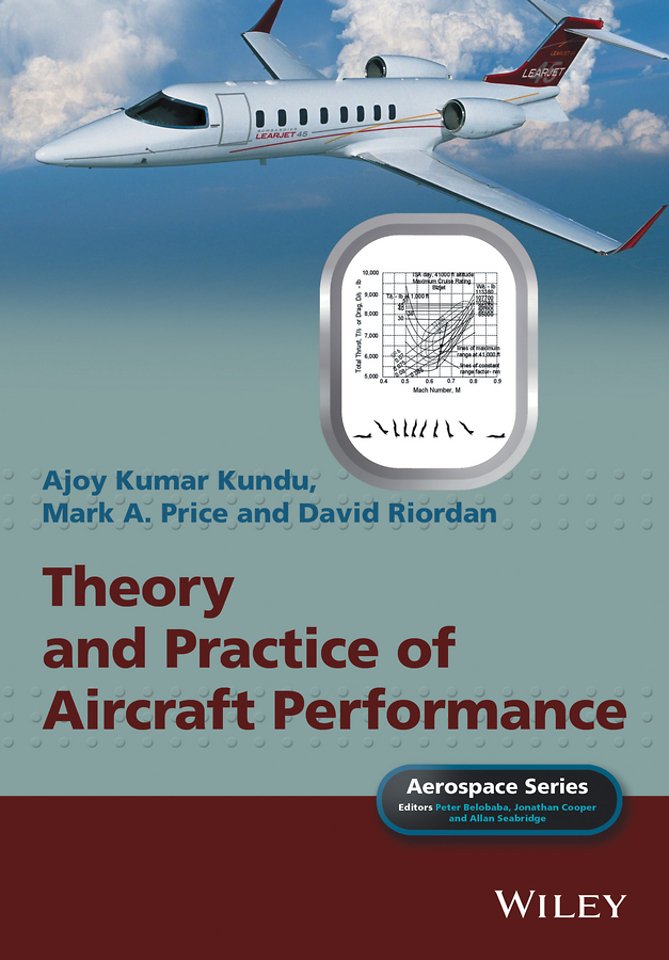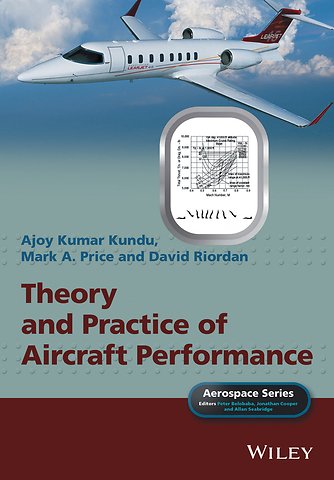Theory and Practice of Aircraft Performance
Gebonden Engels 2016 9781119074175Samenvatting
Textbook introducing the fundamentals of aircraft performance using industry standards and examples: bridging the gap between academia and industry
Provides an extensive and detailed treatment of all segments of mission profile and overall aircraft performance
Considers operating costs, safety, environmental and related systems issues
Includes worked examples relating to current aircraft (Learjet 45, Tucano Turboprop Trainer, Advanced Jet Trainer and Airbus A320 types of aircraft)
Suitable as a textbook for aircraft performance courses
Specificaties
Lezersrecensies
Inhoudsopgave
<p>Series Preface xxi</p>
<p>Road Map of the Book xxiii</p>
<p>Acknowledgements xxvii</p>
<p>Nomenclature xxxi</p>
<p>1 Introduction 1</p>
<p>1.1 Overview 1</p>
<p>1.2 Brief Historical Background 1</p>
<p>1.3 Current Aircraft Design Status 8</p>
<p>1.4 Future Trends 11</p>
<p>1.5 Airworthiness Requirements 14</p>
<p>1.6 Current Aircraft Performance Analyses Levels 16</p>
<p>1.7 Market Survey 17</p>
<p>1.8 Typical Design Process 19</p>
<p>1.9 Classroom Learning Process 23</p>
<p>1.10 Cost Implications 25</p>
<p>1.11 Units and Dimensions 26</p>
<p>1.12 Use of Semi empirical Relations and Graphs 26</p>
<p>1.13 How Do Aircraft Fly? 26</p>
<p>1.14 Anatomy of Aircraft 27</p>
<p>1.15 Aircraft Motion and Forces 30</p>
<p>References 36</p>
<p>2 Aerodynamic and Aircraft Design Considerations 37</p>
<p>2.1 Overview 37</p>
<p>2.2 Introduction 37</p>
<p>2.3 Atmosphere 39</p>
<p>2.4 Airflow Behaviour: Laminar and Turbulent 51</p>
<p>2.5 Aerofoil 56</p>
<p>2.6 Generation of Lift 64</p>
<p>2.7 Types of Stall 71</p>
<p>2.8 Comparison of Three NACA Aerofoils 72</p>
<p>2.9 High Lift Devices 73</p>
<p>2.10 Transonic Effects Area Rule 74</p>
<p>2.11 Wing Aerodynamics 76</p>
<p>2.12 Aspect Ratio Correction of 2D Aerofoil Characteristics for 3D Finite Wing 79</p>
<p>2.13 Wing Definitions 81</p>
<p>2.14 Mean Aerodynamic Chord 84</p>
<p>2.15 Compressibility Effect: Wing Sweep 86</p>
<p>2.16 Wing Stall Pattern and Wing Twist 87</p>
<p>2.17 Influence of Wing Area and Span on Aerodynamics 88</p>
<p>2.18 Empennage 92</p>
<p>2.19 Fuselage 98</p>
<p>2.20 Nacelle and Intake 100</p>
<p>2.21 Speed Brakes and Dive Brakes 106</p>
<p>References 106</p>
<p>3 Air Data Measuring Instruments, Systems and Parameters 109</p>
<p>3.1 Overview 109</p>
<p>3.2 Introduction 109</p>
<p>3.3 Aircraft Speed 110</p>
<p>3.4 Air Data Instruments 122</p>
<p>3.5 Aircraft Flight Deck (Cockpit) Layout 128</p>
<p>3.6 Aircraft Mass (Weights) and Centre of Gravity 133</p>
<p>3.7 Noise Emissions 141</p>
<p>3.8 Engine Exhaust Emissions 145</p>
<p>3.9 Aircraft Systems 146</p>
<p>3.10 Low Observable (LO) Aircraft Configuration 150</p>
<p>References 152</p>
<p>4 Equations of Motion for a Flat Stationary Earth 153</p>
<p>4.1 Overview 153</p>
<p>4.2 Introduction 154</p>
<p>4.3 Definitions of Frames of Reference (Flat Stationary E arth) and Nomenclature Used 154</p>
<p>4.4 Eulerian Angles 158</p>
<p>4.5 Simplified Equations of Motion for a Flat Stationary Earth 161</p>
<p>Reference 167</p>
<p>5 Aircraft Load 169</p>
<p>5.1 Overview 169</p>
<p>5.2 Introduction 169</p>
<p>5.3 Flight Manoeuvres 171</p>
<p>5.4 Aircraft Loads 171</p>
<p>5.5 Theory and Definitions 172</p>
<p>5.6 Limits Loads and Speeds 173</p>
<p>5.7 V n Diagram 174</p>
<p>5.8 Gust Envelope 179</p>
<p>Reference 183</p>
<p>6 Stability Considerations Affecting Aircraft Performance 185</p>
<p>6.1 Overview 185</p>
<p>6.2 Introduction 185</p>
<p>6.3 Static and Dynamic Stability 186</p>
<p>6.4 Theory 192</p>
<p>6.5 Current Statistical Trends for Horizontal and Vertical Tail Coefficients 197</p>
<p>6.6 Inherent Aircraft Motions as Characteristics of Design 198</p>
<p>6.7 Spinning 202</p>
<p>6.8 Summary of Design Considerations for Stability 203</p>
<p>References 207</p>
<p>7 Aircraft Power Plant and Integration 209</p>
<p>7.1 Overview 209</p>
<p>7.2 Background 209</p>
<p>7.3 Definitions 214</p>
<p>7.4 Air Breathing Aircraft Engine Types 215</p>
<p>7.5 Simplified Representation of Gas Turbine (Brayton/Joule) Cycle 219</p>
<p>7.6 Formulation/Theory Isentropic Case 221</p>
<p>7.7 Engine Integration to Aircraft Installation Effects 226</p>
<p>7.8 Intake/Nozzle Design 231</p>
<p>7.9 Exhaust Nozzle and Thrust Reverser 233</p>
<p>7.10 Propeller 234</p>
<p>References 246</p>
<p>8 Aircraft Power Plant Performance 247</p>
<p>8.1 Overview 247</p>
<p>8.2 Introduction 248</p>
<p>8.3 Uninstalled Turbofan Engine Performance Data Civil Aircraft 250</p>
<p>8.4 Uninstalled Turbofan Engine Performance Data Military Aircraft 254</p>
<p>8.5 Uninstalled Turboprop Engine Performance Data 255</p>
<p>8.6 Installed Engine Performance Data of Matched Engines to Coursework Aircraft 257</p>
<p>8.7 Installed Turboprop Performance Data 261</p>
<p>8.8 Piston Engine 264</p>
<p>8.9 Engine Performance Grid 267</p>
<p>8.10 Some Turbofan Data 272</p>
<p>Reference 273</p>
<p>9 Aircraft Drag 275</p>
<p>9.1 Overview 275</p>
<p>9.2 Introduction 275</p>
<p>9.3 Parasite Drag Definition 277</p>
<p>9.4 Aircraft Drag Breakdown (Subsonic) 278</p>
<p>9.5 Aircraft Drag Formulation 279</p>
<p>9.6 Aircraft Drag Estimation Methodology 281</p>
<p>9.7 Minimum Parasite Drag Estimation Methodology 281</p>
<p>9.8 Semi Empirical Relations to Estimate Aircraft Component Parasite Drag 284</p>
<p>9.9 Notes on Excrescence Drag Resulting from Surface Imperfections 295</p>
<p>9.10 Minimum Parasite Drag 296</p>
<p>9.11 CDp Estimation 296</p>
<p>9.12 Subsonic Wave Drag 296</p>
<p>9.13 Total Aircraft Drag 298</p>
<p>9.14 Low Speed Aircraft Drag at Takeoff and Landing 298</p>
<p>9.15 Propeller Driven Aircraft Drag 304</p>
<p>9.16 Military Aircraft Drag 304</p>
<p>9.17 Supersonic Drag 305</p>
<p>9.18 Coursework Example Civil Bizjet Aircraft 306</p>
<p>9.19 Classroom Example Subsonic Military Aircraft (Advanced Jet Trainer) 315</p>
<p>9.20 Classroom Example Turboprop Trainer 319</p>
<p>9.21 Classroom Example Supersonic Military Aircraft 325</p>
<p>9.22 Drag Comparison 332</p>
<p>9.23 Some Concluding Remarks and Reference Figures 334</p>
<p>References 338</p>
<p>10 Fundamentals of Mission Profile, Drag Polar and Aeroplane Grid 339</p>
<p>10.1 Overview 339</p>
<p>10.2 Introduction 340</p>
<p>10.3 Civil Aircraft Mission (Payload Range) 342</p>
<p>10.4 Military Aircraft Mission 345</p>
<p>10.5 Aircraft Flight Envelope 349</p>
<p>10.6 Understanding Drag Polar 351</p>
<p>10.7 Properties of Parabolic Drag Polar 354</p>
<p>10.8 Classwork Examples of Parabolic Drag Polar 363</p>
<p>10.9 Bizjet Actual Drag Polar 366</p>
<p>10.10 Aircraft and Engine Grid 372</p>
<p>References 378</p>
<p>11 Takeoff and Landing 379</p>
<p>11.1 Overview 379</p>
<p>11.2 Introduction 380</p>
<p>11.3 Airfield Definitions 380</p>
<p>11.4 Generalized Takeoff Equations of Motion 384</p>
<p>11.5 Friction Wheel Rolling and Braking Friction Coefficients 389</p>
<p>11.6 Civil Transport Aircraft Takeoff 391</p>
<p>11.7 Worked Example Bizjet 396</p>
<p>11.8 Takeoff Presentation 404</p>
<p>11.9 Military Aircraft Takeoff 405</p>
<p>11.10 Checking Takeoff Field Length (AJT) 406</p>
<p>11.11 Civil Transport Aircraft Landing 409</p>
<p>11.12 Landing Presentation 417</p>
<p>11.13 Approach Climb and Landing Climb 418</p>
<p>11.14 Fuel Jettisoning 418</p>
<p>References 418</p>
<p>12 Climb and Descent Performance 419</p>
<p>12.1 Overview 419</p>
<p>12.2 Introduction 420</p>
<p>12.3 Climb Performance 422</p>
<p>12.4 Other Ways to Climb (Point Performance) Civil Aircraft 428</p>
<p>12.5 Classwork Example Climb Performance (Bizjet) 435</p>
<p>12.6 Hodograph Plot 440</p>
<p>12.7 Worked Example Bizjet 443</p>
<p>12.8 Integrated Climb Performance Computational Methodology 444</p>
<p>12.9 Specific Excess Power (SEP) High Energy Climb 447</p>
<p>12.10 Descent Performance 454</p>
<p>12.11 Worked Example Descent Performance (Bizjet) 459</p>
<p>References 462</p>
<p>13 Cruise Performance and Endurance 463</p>
<p>13.1 Overview 463</p>
<p>13.2 Introduction 464</p>
<p>13.3 Equations of Motion for the Cruise Segment 466</p>
<p>13.4 Cruise Equations 466</p>
<p>13.5 Specific Range 470</p>
<p>13.6 Worked Example (Bizjet) 471</p>
<p>13.7 Endurance Equations 478</p>
<p>13.8 Options for Cruise Segment (Turbofan Only) 481</p>
<p>13.9 Initial Maximum Cruise Speed (Bizjet) 487</p>
<p>13.10 Worked Example of AJT Military Aircraft 488</p>
<p>References 489</p>
<p>14 Aircraft Mission Profile 491</p>
<p>14.1 Overview 491</p>
<p>14.2 Introduction 492</p>
<p>14.3 Payload Range Capability 493</p>
<p>14.4 The Bizjet Payload Range Capability 495</p>
<p>14.5 Endurance (Bizjet) 502</p>
<p>14.6 Effect of Wind on Aircraft Mission Performance 502</p>
<p>14.7 Engine Inoperative Situation at Climb and Cruise Drift Down Procedure 503</p>
<p>14.8 Military Missions 506</p>
<p>14.9 Flight Planning by the Operators 507</p>
<p>References 508</p>
<p>15 Manoeuvre Performance 509</p>
<p>15.1 Overview 509</p>
<p>15.2 Introduction 509</p>
<p>15.3 Aircraft Turn 510</p>
<p>15.4 Classwork Example AJT 520</p>
<p>15.5 Aerobatics Manoeuvre 522</p>
<p>15.6 Combat Manoeuvre 528</p>
<p>15.7 Discussion on Turn 530</p>
<p>References 531</p>
<p>16 Aircraft Sizing and Engine Matching 533</p>
<p>16.1 Overview 533</p>
<p>16.2 Introduction 534</p>
<p>16.3 Theory 535</p>
<p>16.4 Coursework Exercises: Civil Aircraft Design (Bizjet) 541</p>
<p>16.5 Sizing Analysis: Civil Aircraft (Bizjet) 543</p>
<p>16.6 Classroom Exercise Military Aircraft (AJT) 546</p>
<p>16.7 Sizing Analysis Military Aircraft 551</p>
<p>16.8 Aircraft Sizing Studies and Sensitivity Analyses 553</p>
<p>16.9 Discussion 554</p>
<p>References 558</p>
<p>17 Operating Costs 559</p>
<p>17.1 Overview 559</p>
<p>17.2 Introduction 560</p>
<p>17.3 Aircraft Cost and Operational Cost 561</p>
<p>17.4 Aircraft Direct Operating Cost (DOC) 567</p>
<p>17.5 Aircraft Performance Management (APM) 574</p>
<p>References 577</p>
<p>18 Miscellaneous Considerations 579</p>
<p>18.1 Overview 579</p>
<p>18.2 Introduction 579</p>
<p>18.3 History of the FAA 580</p>
<p>18.4 Flight Test 583</p>
<p>18.5 Contribution of the Ground Effect on Takeoff 585</p>
<p>18.6 Flying in Adverse Environments 586</p>
<p>18.7 Bird Strikes 590</p>
<p>18.8 Military Aircraft Flying Hazards and Survivability 591</p>
<p>18.9 Relevant Civil Aircraft Statistics 591</p>
<p>18.10 Extended Twin Engine Operation (ETOP) 597</p>
<p>18.11 Flight and Human Physiology 598</p>
<p>References 599</p>
<p>Appendices</p>
<p>Appendix A Conversions 601</p>
<p>Appendix B International Standard Atmosphere Table 605</p>
<p>Appendix C Fundamental Equations 609</p>
<p>Appendix D Airbus 320 Class Case Study 615</p>
<p>Appendix E Problem Sets 627</p>
<p>Appendix F Aerofoil Data 647</p>
<p>Index 655</p>
Rubrieken
- advisering
- algemeen management
- coaching en trainen
- communicatie en media
- economie
- financieel management
- inkoop en logistiek
- internet en social media
- it-management / ict
- juridisch
- leiderschap
- marketing
- mens en maatschappij
- non-profit
- ondernemen
- organisatiekunde
- personal finance
- personeelsmanagement
- persoonlijke effectiviteit
- projectmanagement
- psychologie
- reclame en verkoop
- strategisch management
- verandermanagement
- werk en loopbaan

